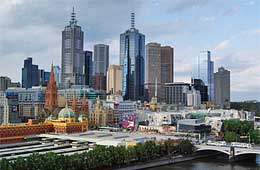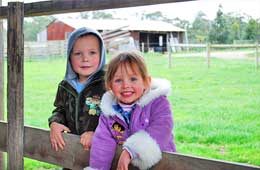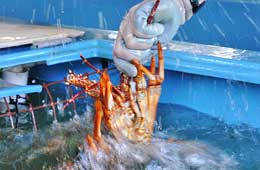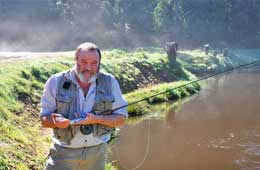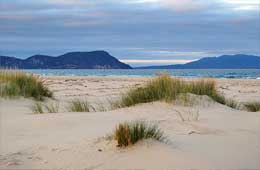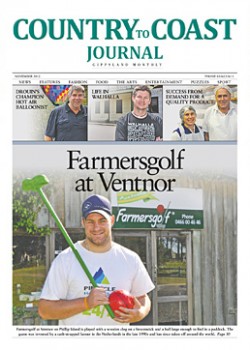MIRROR IMAGE – Outback magazine
AN Australian pub can be a great place to eat drink and relax with friends however, while it may have the best range of drinks and the best food, it is character and atmosphere that makes a pub special and a great social environment.
Much of the magnificent, rustic, commercial artwork that creates atmosphere in many Australian pubs is the work of talented sign writer, Glenn Joyner. Glenn specialises in manufacturing hotel ambience. He has a thriving business called Pub Art, formally Glenn Joyner and Company, situated on his country property in Rokeby, Victoria. There, he is assisted by his long time friend and associate Kev Burke. With designing, building and painting, he has created atmosphere in 27 hotels. He has also manufactured hotel promotional material for Jim Beam, Carlton and United Brewery and Jack Daniels.
“I demolish and rebuild ambience in hotels,” he says. His manufacturing facility is a hive of activity with its own unique atmosphere and employs 10 fulltime staff or ‘mates’. “Everything is created here from start to finish,” he says. “We do the joinery, all the timber mouldings, all the glasswork and make the bars. We make barrels, pool tables, pool table lights, drink dispensers, pub mirrors and other promotional items. I use small buildings, old trucks, Harley motorbikes and practically anything else one can think of for display work.”
In 1994 and 1998, he received the Australian Hotel Associations ‘Best Bar of the Year’ awards. Both bars are in a hotel called Harp of Erin in Kew, Victoria, where he designed one with a timber tapestry set into it in six different hardwoods. He says many of the signs he paints are on old iron and reclaimed Australian timber.
While talking to him in his office, its hard not to notice a large rustic, beautifully built cabinet with a hand painted sign behind its glass face. He says they built it from the floor of the Horsham Presbyterian Church. “I purchased the whole floor. I have used timber from many places including the old wharves in Echuca and old wool stores.” He says most of what he manufactured for Jim Beam in 1992 they made from the Ghan railway line. “Every pub I go into in Australia usually has something in it that has been made here at Rokeby.”
Glenn completed a sign writing apprenticeship in 1981 with several prestigious awards. “We didn’t use computers then, we used a brush,” he says. “By the time I finished I could do a perfect ½ inch or 12 millimetre Helvetica letter, but those skills aren’t valued today; they’ve been replaced by technology.”
Before commencing his apprenticeship, Glenn attended Fairhills High School in Ferntree Gully where he excelled in graphics and art. After completing year 11, he took his school certificate to what was then The Industrial Training Commission and told them he wanted to be a sign writer. “Back then it was cool to be a sign writer,” he says. “I could wear shorts and work outside when the sun was out, and work inside when it was cold. I was devastated when the man I saw suggested that I consider another trade. He told me he had 600 to 1000 young blokes like me wanting to be sign writers and that there were only about 15 vacancies a year. I insisted on wanting to be a sign writer so he eventually wished me luck.”
Glenn was offered two apprenticeships and chose to work with Frawleys in Ferntree Gully, a company that is still there today. “I was an apprentice and Kev Burke was a tradesman who had just started working there, so we have been mates for a long time. Now he is my company director. He’s a cynical old bastard but he keeps me in check.”
While working at Fawleys, Glenn met Ray Bekerley who was the supervisor there. “He was an extremely gifted man,” he says. “When he left the company and started working for himself making movie props for movie production companies, I joined him. We worked on the Mad Max movie set which was a low budget movie with a no name actor called Mel Gibson but it smashed all box office expectations. We then worked on props for a movie called Death of a Soldier about Leonsky who was an American soldier on leave that raped and murdered a Melbourne girl in 1939. We had a decent sized budget to work with so I had a list of things to do for the set. It included doing beautiful old acid etched details in glass for the hotel in the movie and 30 sets of 1939 number plates. They all had five digits so I used all my mates’ phone numbers. I was asked to reproduce three or four pub mirrors just good enough for the celluloid meaning I didn’t need to use materials like real 22-carat gold. I decided then that I wanted to one day do beautiful work on old pub mirrors. I worked for Ray for a short period and then developed my own company called ‘Color Sign’.”
In the late 1980s, Glenn left the city and purchased vacant land at Rokeby with a vision of what he wanted the place to be like, and what he wanted to do. “I wanted to replicate 100 year old pub mirrors like those that I had done for the movie set,” he says. “They were hand gilded in 23-carat gold and all the pictorial work they reversed on glass and did by hand. It’s difficult doing a portrait on the back of a mirror when I can’t see the paint on the other side, so I have to paint using another mirror to see it.”
After spending three to four months hand painting, no one in the industry wanted to see him until June in 1991 when he showed his work to Jim Beam, a company that produced bourbon whisky. He then worked exclusively for them for 10 years. He says in the bourbon category Jim Beam had 65% of the market and in 1999, they merged worldwide with two companies. “They paid me to fly overseas to different European countries including Bulgaria, Russia, Hungary and Czechoslovakia to work with prospective importing companies. This was to work out how these countries perceived the bourbon, because in Australia people drink five times more Jim Beam per capita than they do in America. After the merger, there were some changes made within the company and the director left. “He asked me to move with him to Jack Daniels where he was to be managing director,” Glenn says. “Initially Jack Daniels didn’t give us the volume of work we anticipated but now we are flat out.”
Kev says he has worked with Glenn forever. “It seems that way,” he says. “He’s outlasted two wives. We have moments when we butt heads like all relationships. Glenn is very creative and I’m more of a numbers man but we compliment each other and the balance seems to come up right.”
Glenn is presently working on creating the right atmosphere for a new wine and piano bar in Warragul, Victoia. He is also building bars for the domestic market from beautiful Australian hardwoods. He sells them from the Rokeby premises and through ‘On Tap’ in Darling Harbour, New South Wales, which is one of the most, recognised shops for hotel memorabilia in Australia today.
By Wendy Morriss (formerly Thompson)
Copyright © 2012 Wendy Morriss: Freelance Journalist. All Rights Reserved.
